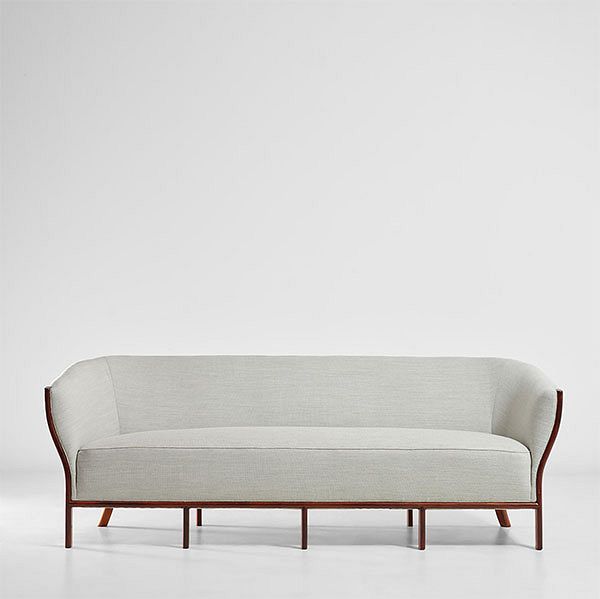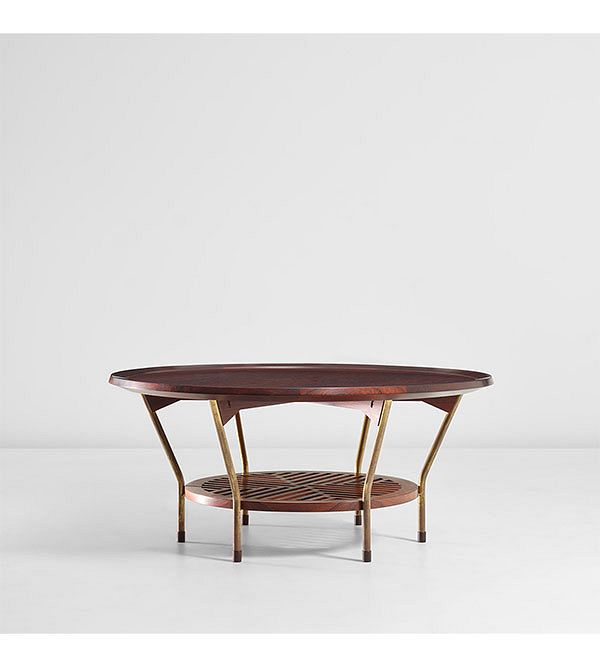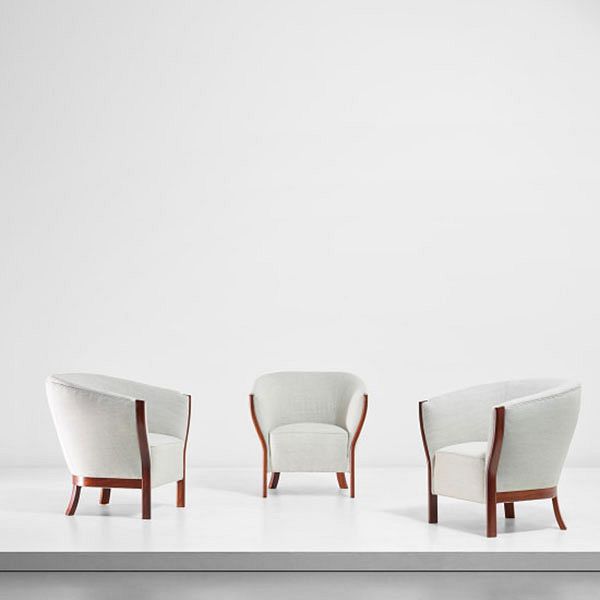Frits Schlegel, Set of three easy chairs, circa 1949. Design London.
Written by Marie-Louise Høstbo
In Denmark, few architects surpass Frits Schlegel (1896-1965) in the use of concrete in construction. He exhibited both a classical training and the will to explore new materials and construction methods in his formal idiom. Whether the client was private or represented the public sector, the works were intimate and understated. Schlegel trained as a mason and studied to become an architect at the Royal Danish Academy of Fine Arts. He graduated in 1923 and worked with different architects before setting up his own studio in 1934, which he continued until his death in 1965. Schlegel dissociated himself from historicism and monumentality. Instead, he created his own distinctive interpretation of functionalism. He was sophisticated and extremely disciplined. Several of his projects are considered works of total design, Gesamtkunstwerke. For a villa in-situ cast in concrete, he used the exquisite Cuban mahogany for the cladding panels of the hall. This contrast is significant for his work. Schlegel's works are stylish, delicate, and bright — they are Danish with an international context.

Frits Schlegel, Unique couch, circa 1949. Design London.
The present unique lots were designed for resistance fighter Erik Nyegaard's villa circa 1949. His original home was bombed by the Germans during the Second World War. Nyegaard was a passionate member of the resistance movement and hid one of its more prominent members in his home which cost him imprisonment. After the war, Nyegaard returned to the site of his destroyed home and collaborated with Schlegel on several proposals for a new villa. The final project was designed in 1947 and completed in 1949. The close partnership during the project for the Nyegaard villa developed into a personal friendship between Nyegaard and Schlegel. The villa is located 10 kilometers north of Copenhagen on an undulated ground which Schlegel harnessed by designing a villa with several partitions that made the most of the sea view. In breaking up the architecture in numerous volumes, the villa stands vibrantly. The different volumes are gathered by the same roof pitch throughout and wooden cladding contrasting the brick walls.
The architecture finds references in the Arts and Crafts movement, Prairie-style architecture, and the Danish functional tradition. The result is unmistakably a work by Schlegel showcased in his knowledgeable approach to international trends and talented craftsmanship. The layout is very simple and elegant. By using the different levels of the ground, the villa is divided into a variety of spaces and stands as a complete work. The significant roofs emphasize the strong architecture and the chimney stacks define the verticality of the architecture. The Nyegaard villa connects regional materials with the Danish building tradition to a modern and international idiom. The result is a complex house featuring several volumes together, united in close interaction to the location.

Frits Schlegel, Unique coffee table, circa 1949. Design London.
Strandvejen, where the villa is located, connects Copenhagen to the towns north of the city. It runs along the seaside and the villas are visually connected to the sea. Just north of the Nyegaard villa, Arne Jacobsen designed what is considered a small town in itself, Bellevue, consisting of apartment buildings, terraced houses, restaurants, a petrol station, a beach park, and a theatre. It is an affluent area and the approach to architecture is a work of total design, including the well-being of the inhabitants.
Frits Schlegel's oeuvre holds different projects, commercial or private. Early in his career he was deeply inspired by the works of French architect Auguste Perret (1874-1954). Mariebjerg Chapel and Crematorium, as well as the Public Trustee's Office in Copenhagen are wonderful examples of how inspiration can result in characteristic and exceptional independent works. For both projects Schlegel designed the furniture as well as the building. For the Public Trustee´s Office, the furniture was made both by cabinetmakers and more industrial production. Schlegel's furniture designs show his international inspiration by standing out as works of craftsmanship and knowledge. Like the inspiration from Perret's concrete work interpreted in a Danish idiom, Schlegel also found inspiration in international furniture design as well. Frits Schlegel was a visionary and he pushed the boundaries of how to work with both concrete and steam bending in Denmark. He worked with other significant Danish architects such as Mogens Lassen, Edvard Thomsen, Vilhelm Lauritzen and Hans Hansen, with whom he designed the wonderful Tivoli Concert Hall.

Frits Shlegel, Unique pair of side tables, circa 1949. Design London.
The forms of his chair design, such as the chairs and benches for Søndermark Chapel and Crematorium, which he designed with Edvard Thomsen in 1929, show how the shapes of the chairs are emphasized by the Nordic light cascading into the space from a single high window in one corner of the chapel. This is magnificent and well articulated design and architecture. The steam bent chairs were made with the furniture company Fritz Hansen, the leading Danish firm working with this technique at the time. Schlegel experimented with the materials, and he was attentive to trends and innovative production methods. Schlegel also developed a series of chairs made in steel tube with Hansen.
A consistant part of modern Danish design was the architect's capacity to work in a variety of scales — often a given project encompassed the shaping of the surrounding landscape, the construction, and the interior decoration. The present set of furniture from the Nyegaard villa is crafted in Brazilian rosewood with metal details. The combinations of wood and metal are emphasized in the shapes of the furniture. The softly rounded wood is contrasted in the clarity of the well defined transition from leg to armrest. Reflections on traditional furniture are visible in the execution of the pieces, which are meticulously made and show exquisite craftsmanship. The constellation of forms creates a unity of elegance and function. The works of Frits Schlegel cover buildings in the Copenhagen Zoo, official buildings, villas furniture and lighting design. The mass of his concrete uses in architecture contrasts with the delicate features of his furniture designs. His works holds a variety of details to be examined close by or from afar, showing Schlegel's capacity to operate in different scales.
Marie-Louise Høstbo is a Danish architect and aesthetic and creative consultant within the fields of photography, design and architecture. Her book, Secret Places: The Architect’s Guide to Distinctive Buildings in and Around Copenhagen, was published in 2019 by Strandberg Publishing. With 25 years of experience in the industry, she specializes in Danish design and architecture.
Discover More from Design Online >
Recommended Reading
The Prompt: Teapot by Bonnie Seeman >
